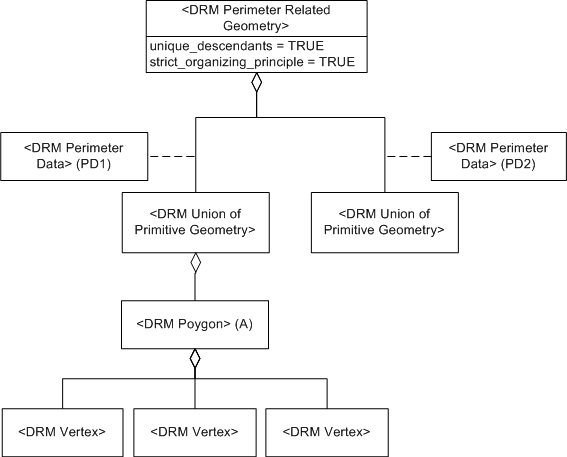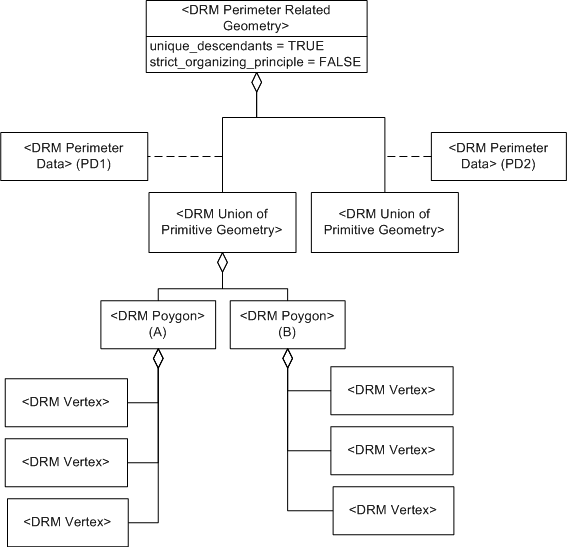Class Name: Perimeter Related Geometry
Subclasses
This DRM class is concrete and has no subclasses.
Definition
An instance of this DRM class is
an <Aggregate Geometry> instance that spatially
organizes its <Geometry Hierarchy>
components into a collection of (potentially) irregularly shaped regions,
each defined by a <Perimeter Data> link object.
That is, each <Geometry Hierarchy> component is
contained within the perimeter area specified by
the <Perimeter Data> link object associated with
that component.
Primary Page in DRM Diagram:
Secondary Pages in DRM Diagram:
This class appears on only one page of the DRM class diagram.
Example
Consider a <Perimeter Related Geometry> instance
PRG with two branches, each with a
distinct <Union Of Primitive Geometry> component
as depicted in
Figure 36.

Figure 36 — <DRM Perimeter Related Geometry> example, strict_organizing_principle = TRUE
By the constraint specified in
<<Perimeter Related Organizing Principle>>,
at least one of the vertices of A
shall fall within the region described by the
<Perimeter Data> link object
PD1. If PRG has
strict_organizing_principle
= SE_TRUE, all the vertices
of A do so.
Consider a second <Polygon> instance
B, a sibling of A
within UPG1 as depicted in
Figure 37.

Figure 37 — <DRM Perimeter Related Geometry> example, strict_organizing_principle = FALSE
B falls on the boundary dividing the
regions described by PD1 and
PD2, such that at least one of
B's vertices falls within
PD1 and at least one of
B's vertices falls
PD2.
By the constraint specified in
<<Perimeter Related Organizing Principle>>, the
strict_organizing_principle
flag of PRG shall be set to
SE_FALSE,
since branches are present that do not fully contain
their DRM objects.
FAQs
-
May the regions defined by the components of a
<Perimeter Related Geometry> instance overlap?
See
<<Perimeter Related Organizing Principle>>
-
May the same <Geometry Representation>
be contained within more than one of the components of a
<Perimeter Related Geometry>
instance?
See
<<Perimeter Related Organizing Principle>>
-
Does each of the components of a
<Perimeter Related Geometry>
instance form an independent topological surface?
Normally, yes. In this case, each
<Geometry Hierarchy> component has its own
<Geometry Topology Hierarchy> component.
However, the <Geometry Topology>
instances in all the components may also form a single topological surface,
in which case only the
<Perimeter Related Geometry>
instance itself has such a topology hierarchy.
Constraints
Associated to (one-way) (inherited)
Associated by (one-way) (inherited)
Composed of (two-way) (inherited)
Composed of (two-way)
Composed of (two-way metadata) (inherited)
Component of (two-way) (inherited)
- zero or more <Alternate Hierarchy Related Geometry> instances, each through the use of a <Hierarchy Data> link object
- zero or more <Animation Related Geometry> instances
- zero or more <Classification Related Geometry> instances, each through the use of a <Classification Data> link object
- zero or one <Environment Root> instance
- zero or one <Geometry Model> instance
- zero or more <LOD Related Geometry> instances, each through the use of a <Base LOD Data> link object
- zero or more <Octant Related Geometry> instances, each through the use of an <Octant Data> link object
- zero or more <Perimeter Related Geometry> instances, each through the use of a <Perimeter Data> link object
- zero or more <Quadrant Related Geometry> instances, each through the use of a <Quadrant Data> link object
- zero or more <Separating Plane Relations> instances, each through the use of a <Separating Plane Data> link object
- zero or more <Spatial Index Related Geometry> instances, each through the use of a <Spatial Index Data> link object
- zero or more <State Related Geometry> instances, each through the use of a <State Data> link object
- zero or more <Time Related Geometry> instances, each through the use of a <Time Constraints Data> link object
- zero or more <Union Of Geometry Hierarchy> instances
Notes
Associated to Notes
An association between a
<Feature Representation>
instance and a
<Geometry Hierarchy> instance
indicates that the environmental object(s) that they
represent have the semantic relationship indicated by
the <Base Association Data>
link object on the association relationship.
An association between two
<Geometry Hierarchy> instances
indicates that the environmental object(s) that they
represent have the semantic relationship indicated by
the <Base Association Data>
link object on the association relationship.
Associated from Notes
An association between a
<Feature Representation>
instance and a
<Geometry Hierarchy> instance
indicates that the environmental object(s) that they
represent have the semantic relationship indicated by
the <Base Association Data>
link object on the association relationship.
An association between two
<Geometry Hierarchy> instances
indicates that the environmental object(s) that they
represent have the semantic relationship indicated by
the <Base Association Data>
link object on the association relationship.
An association from a
<Hierarchy Summary Item>
instance to a <Geometry Hierarchy>
instance indicates that the
<Hierarchy Summary Item> instance
summarizes that <Geometry Hierarchy>
instance.
An association from a
<Reference Surface> instance to a
<Geometry Hierarchy> instance indicates
that the <Geometry Hierarchy>
instance organizes the geometric objects that specify
the reference surface geometry of the
<Reference Surface> instance.
Composed of Notes
In the case where multiple
<Collision Volume> components are
specified for the
<Aggregate Geometry> instance,
the union
of the volumes thus specified is used in collision detection.
An <Aggregate Geometry> instance can have
an <LSR Transformation> component only when the
<Aggregate Geometry> instance is within
the scope of an LSR 3D SRF.
Fields Notes
If the value of the
unique_descendants
field is SE_TRUE, each
descendant of this aggregation, that is, each
<Geometry Representation>
instance that exists in the component tree
rooted at the <Aggregate Geometry>
instance shall be unique, in the
sense that it shall appear in only one branch
of this aggregation.
If unique_descendants
is SE_FALSE, at least one
<Geometry Representation> instance
appears in more than one branch of the aggregation.
If the value of the
strict_organizing_principle
field is SE_TRUE, each
branch of this aggregation
strictly complies with the organizing principle for its
particular subclass. If this value is
SE_FALSE, at least
one branch does not strictly comply with the given
organizing principle. See the organizing principle constraint
for each specific subclass for details.
Prev: Perimeter Related Features.
Next: Perimeter Related Geometry Topology.
Up:Index.

